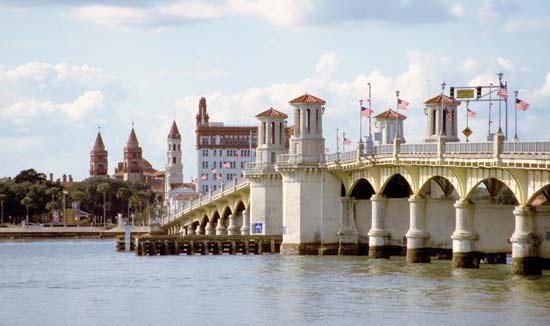Saint Augustine
Florida, United States
 oldest continuously settled city in the United States, seat (1822) of St. Johns county, northeastern Florida, about 40 miles (65 km) southeast of Jacksonville. It is situated on a peninsula between two saltwater rivers, the San Sebastian (west) and Matanzas (east), and on the mainland west of the San Sebastian, just inland from the Atlantic coast on the Intracoastal Waterway.
oldest continuously settled city in the United States, seat (1822) of St. Johns county, northeastern Florida, about 40 miles (65 km) southeast of Jacksonville. It is situated on a peninsula between two saltwater rivers, the San Sebastian (west) and Matanzas (east), and on the mainland west of the San Sebastian, just inland from the Atlantic coast on the Intracoastal Waterway.The Spanish explorer Juan Ponce de León (Ponce de León, Juan), in search of the legendary Fountain of Youth, landed there in 1513 and took possession of the territory for Spain. In 1564 France established Fort Caroline near the mouth of the St. Johns River (Saint Johns River), about 35 miles (55 km) north. A year later, in order to maintain Spanish sovereignty over Florida, Pedro Menéndez de Avilés (Menéndez de Avilés, Pedro) destroyed the French colony and founded the city, which he named for St. Augustine (Augustine, Saint), bishop of Hippo, upon whose feast day he had sighted the coast. Except for the 20 years (1763–83) that Florida belonged to England, throughout the following 256 years it was the main northern outpost of the Spanish colonial empire.
 Since 1821 the city has been a part of the United States. A remaining symbol of former Spanish power is the massive Castillo de San Marcos (Castillo de San Marcos National Monument), built in 1672–95 near the southern tip of the peninsula; the oldest masonry fort standing in the United States, it is now a national monument. The city was plundered (1586) by the English sea raider Sir Francis Drake (Drake, Sir Francis), burned (1702) by Governor James Moore of Carolina, and besieged (1740) by the British general and leader of the Georgia Colony, James Edward Oglethorpe (Oglethorpe, James Edward); it became a refuge for loyalists (loyalist) during the American Revolution and during the Seminole Wars provided a prison for captured Seminole Indians, including Osceola. Union troops occupied it the last three years of the American Civil War.
Since 1821 the city has been a part of the United States. A remaining symbol of former Spanish power is the massive Castillo de San Marcos (Castillo de San Marcos National Monument), built in 1672–95 near the southern tip of the peninsula; the oldest masonry fort standing in the United States, it is now a national monument. The city was plundered (1586) by the English sea raider Sir Francis Drake (Drake, Sir Francis), burned (1702) by Governor James Moore of Carolina, and besieged (1740) by the British general and leader of the Georgia Colony, James Edward Oglethorpe (Oglethorpe, James Edward); it became a refuge for loyalists (loyalist) during the American Revolution and during the Seminole Wars provided a prison for captured Seminole Indians, including Osceola. Union troops occupied it the last three years of the American Civil War.St. Augustine's economy is based on tourism (first promoted in the 1880s by the financier-railroad magnate Henry M. Flagler (Flagler, Henry M), a pioneer in Florida development), services, industry (including aircraft modification and the manufacture of aluminum products and boats), and commercial and sport fishing. The parent company of the Florida East Coast Railway has its headquarters there. Many Spanish colonial buildings and sites have been restored, including the cathedral (1791), Oldest House (begun in 1723), Ximenez-Fatio House (c. 1797), and the Spanish Quarter, a restored 18th-century village. The city has several museums, including the Lightner Museum, the St. Augustine Lighthouse and Museum, and the Government House Museum. Marineland of Florida is about 15 miles (25 km) south. Southeast of the city on Anastasia Island are Anastasia State Recreation Area and Fort Matanzas National Monument. The city is the seat of Flagler College (1968), whose main building is the first large hotel built (1888) by Flagler. Pop. (2000) 11,592; (2007 est.) 12,284.
- Shenzhou
- Shenzhou spaceflights
- Shenzong
- Sheopur
- Shepard, Alan B., Jr.
- Shepard, Francis P
- Shepard, Sam
- Shepherd of Hermas
- shepherds, adoration of the
- shepherd's purse
- Shepherdstown
- Shepherd, William Robert
- Shepp, Archie
- Sheppard, Jack
- Sheppard, Kate
- Sheppard, Mel
- Shepparton
- Sheppey, Isle of
- Shepstone, Sir Theophilus
- Shepway
- sheqel
- sherardizing
- Sheraton, Thomas
- sherbet
- Sherbo, Vitaly